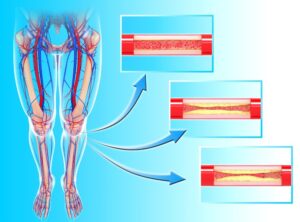Critical Limb Ischemia
Critical limb ischemia (CLI) is a severe form of peripheral arterial disease (PAD) that occurs when there is a blockage or narrowing of the arteries that supply blood to the legs and feet. This condition causes a significant reduction in blood flow to the affected limb, leading to pain, numbness, and tissue damage that can progress to skin ulcers, gangrene, and even limb loss.
 CLI is typically caused by a buildup of plaque within the arteries, a condition called atherosclerosis. Other risk factors for CLI include:
CLI is typically caused by a buildup of plaque within the arteries, a condition called atherosclerosis. Other risk factors for CLI include:
- Smoking
- Diabetes
- High blood pressure
- High cholesterol
CLI can be diagnosed through a physical examination, imaging tests such as an ultrasound, CT angiogram, or magnetic resonance angiogram (MRA).
Symptoms
The symptoms of critical limb ischemia can vary depending on the severity of the disease and the extent of blood flow restriction to the affected limb. Some common symptoms of CLI include:
- Pain or discomfort in the legs, feet, or toes, especially during physical activity or when walking
- Numbness or weakness in the legs, feet, or toes
- Coldness or changes in skin color in the affected limb
- Wounds or ulcers on the toes, feet, or legs that do not heal or heal very slowly
- Gangrene, which is a condition where the tissues in the affected limb begin to die
- Weak or absent pulses in the affected limb
- Poor nail and hair growth on the affected limb
The symptoms of CLI often develop slowly over time, and people may not notice them until they become severe. Some people with CLI may also experience symptoms of underlying cardiovascular disease, such as chest pain, shortness of breath, or fatigue.
Treatment for CLI often involves a combination of lifestyle changes, medications, and procedures to restore blood flow to the affected limb. Lifestyle changes may include quitting smoking, regular exercise, and a healthy diet. Medications may include aspirin, cholesterol-lowering drugs, and medications to manage blood sugar levels. In more severe cases, procedures such as angioplasty, stenting, or bypass surgery may be necessary to restore blood flow.
Treatment: Angioplasty and Stent
Depending on the severity of your symptoms, angioplasty and stent placement is a minimally invasive, outpatient procedure that quickly resolves blood flow through the artery without surgery.
The Procedure
While sedated, a small balloon catheter is inserted into the narrowed or blocked blood vessel, through the femoral or radial artery. The catheter is then guided to the blocked artery using imaging guidance. A small balloon at the tip of the catheter is then inflated to widen the narrowed area and improve blood flow.
Next, a small metal mesh tube called a stent will be inserted into the affected artery to help keep it open after the balloon is deflated and removed. The stent will remain in place permanently and acts as a scaffold to support the artery and prevent it from compressing or narrowing.
Recovery
Insurance
Nearly all insurance companies, including Medicaid and Medicare, will cover angioplasty and vascular stenting for Critical Limb Ischemia.
Our team will work with insurance companies to verify coverage for your consultation as well as any procedures you may require.
The Next Step
If you are experiencing any of these symptoms, it is important to see your healthcare provider as soon as possible. They will work with our TRA Endovascular team to promptly evaluate and treat your condition. Early diagnosis and treatment of CLI can help prevent serious complications and improve outcomes.
Have Questions?
Contact UsAdditional Resources: Radiologyinfo.org
